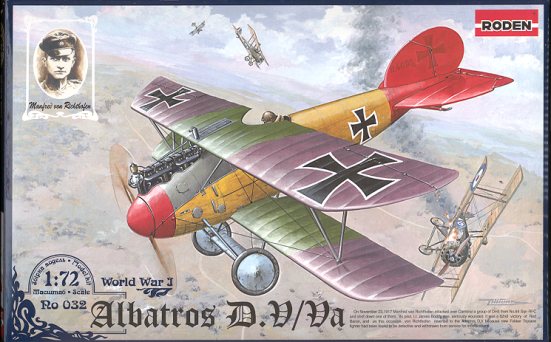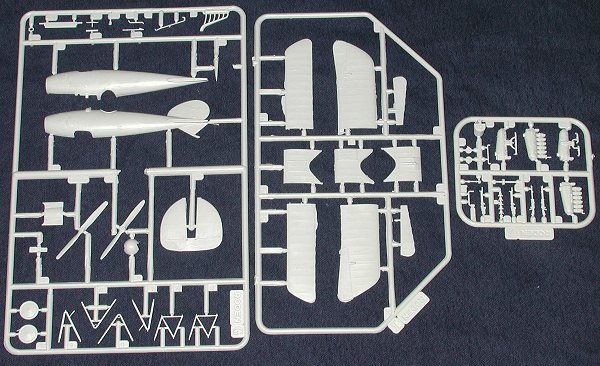|
KIT: |
Roden 1/72
Albatros D.V / D.Va |
|
KIT # |
032 |
|
PRICE: |
$8.98 MSRP ($7.96
at Squadron) |
|
DECALS: |
6 aircraft |
|
REVIEWER: |
Scott Van Aken
|
|
NOTES: |
|

Along with the beginning of production of the Albatros D III plane under the
license at the OAW plant, the Albatros Flugzeugwerke started to work on
further modernization of this fighter. A new prototype, the D.IV appeared;
however, due to poor performance this project was soon abandoned. The next
version, the D.V, br>had the same wing shape as the D.III, but the design of
the fuselage had been completely revised: all of its cross-sections were oval,
unlike the flat-sided fuselage of the aircraft's predecessors. Thus, one of
the most elegant fighters ever built was introduced. Apart from the new
fuselage, the D.V had a rudder of rounded shape, similar to the D.III OAW, and
the underfin had a more raked appearance. The aileron controls on the D.V
passed through the upper wing; like the British S.E.5, this aircraft had a
headrest just behind the cockpit. In comparison with the D.III, the wing gap
had been reduced from 1.54 m to 1.47 m.
The first series production D.V fighters arrived at the front in May 1917.
Their appearance did not cause the same sensation as had earlier versions of
this aeroplane -- by this time new allied fighters were of better performance
than the D.V fighters. Yet another unsolved problem inherited from D.III was
the lower wing failures followed by numerous fatal accidents;
twenty-three pilots were killed during the first three months of the
aircraft's service because of this structural failure.
However, despite the aforementioned problems, 900 aircraft of the D.V type
were built. The increasing activity of the Allied Forces made Germany build
more and more fighters. The Albatros Flugzeugwerke was the only manufacturer
capable of producing aircraft in large quantities.
In the second half of 1917 another sub-modification - the D.Va - appeared. The
major difference of this version was the absence of the headrest in response
to pilots' complaints about the worsening of field of view to the rear.
Also, the aileron control cables were now led through the lower wing. The gap
was reduced again - this time by 38 mm.
The Albatros parent plant produced 1,012 D.Va aircraft; the subsidiary OAW
plant produced another 600 planes of this type.
This fighter was considered already obsolete at the beginning of its service,
but if flown by an experienced pilot it could be a very effective weapon.
Famous aces like Manfred von Richthofen, Ernst Udet, Erich Loewenhardt and
others scored many victories flying the D.V and the D.Va.
At the beginning of 1918 the Albatros D.V/D.Va was Germany's most numerous
fighter. In May there were 1,117 airplanes of both versions in combat units
(131 type D.V machines and 986 D.Vas), over 50% of the total number of German
fighters. Only the production of the famous Fokker D.VII by the Albatros and
OAW plants made the Albatros D.V/D.Va fade into the background. However, these
aeroplanes still remained in service until the last days of war.
Thanks to Roden's instructions for the historical background.

Those who have been fortunate enough to build
the earlier Albatros D.III kits from Roden have remarked at what nice builds
they have been. Moving on from the D.III, they have now started to tackle the
D.V series of aircraft. As you might expect, the wings (which were the same)
have been transported over from the earlier series and a new fuselage and other
D.V specific bits have been added.
The wing sprue is a bit flashy, but nothing major at all. The other two sprues
are pretty clean. I did my usual searching for molding glitches, and other than
a few ejector pin marks on the interior (which really won't be a problem),
didn't find any of consequence. I should mention that several of the parts are
quite petite so removing them from the sprues will require some extra caution so
that they are not broken. There are quite a few optional parts on the sprue, but
the only one for this kit is the headrest.
 Instructions have always been a
strong suite for Roden and to me, are some of the best around. They provide
simple and informative construction sequences that include any modifications or
colors needed. However, they do not provide a rigging diagram, though you can
glean much of that information from the box art. The decals themselves are well
printed and matte.
Instructions have always been a
strong suite for Roden and to me, are some of the best around. They provide
simple and informative construction sequences that include any modifications or
colors needed. However, they do not provide a rigging diagram, though you can
glean much of that information from the box art. The decals themselves are well
printed and matte.
Markings are provided for six aircraft:
- Albatros D.V, Jasta 27, Oblt. Hermann Georing, mid 1917.
- Albatros D.V, w/n 1177/17 Jasta 11, Manfred von Richthofen, June 1917
- Albatros D.Va, Jasta 56, Franz Schlieff, early 1918.
- Albatros D.V, Jasta 10, Oblt. Ernst von Althaus, July 1917.
- Albatros D.Va, Jasta 6, Oblt. Eduard von Dostler, 1917.
- Albatros D.Va, Jasta 5, flown by Josef Mai, 1917.
Since the Albatros has a plywood fuselage, many of the schemes incorporate
this. Most also have the mauve and green upper wings with light blue undersides.
Paints are keyed to Humbrol so if you have them available, it would be your best
bet.
I'm sure this one will be a good seller. There are kits already of this plane
in this scale by Revell and Airfix, but this one is MUCH more detailed and will
be sure to please. Late note: I've also been informed the Eduard makes this kit
in 1/72 as well.
Thanks to the fine folks at
 . Visit
them by clicking on the logo.
. Visit
them by clicking on the logo.
You can find this kit and many others at

If you would like your product reviewed fairly and fairly quickly by a
site that has well over 175,000 visitors a month, please contact
me or see other details in the Note to
Contributors.
Back to the Main Page
Back to the Previews Index Page



 Instructions have always been a
strong suite for Roden and to me, are some of the best around. They provide
simple and informative construction sequences that include any modifications or
colors needed. However, they do not provide a rigging diagram, though you can
glean much of that information from the box art. The decals themselves are well
printed and matte.
Instructions have always been a
strong suite for Roden and to me, are some of the best around. They provide
simple and informative construction sequences that include any modifications or
colors needed. However, they do not provide a rigging diagram, though you can
glean much of that information from the box art. The decals themselves are well
printed and matte. . Visit
them by clicking on the logo.
. Visit
them by clicking on the logo.